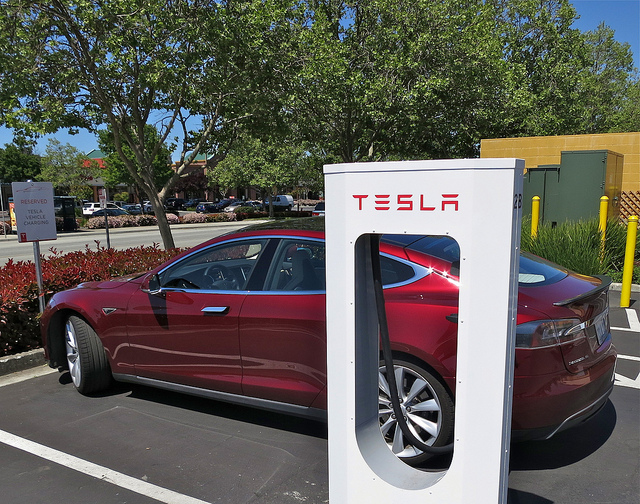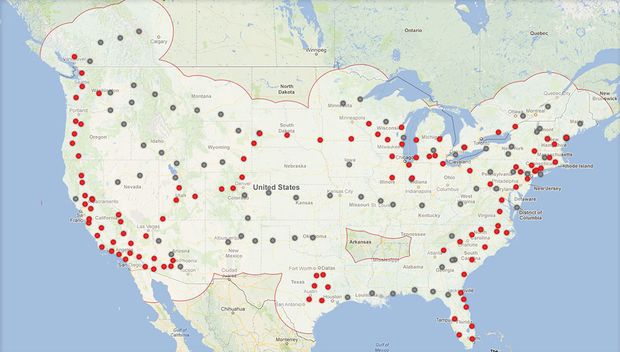Recently I wrote about the launch of supercharger stations in California for the Tesla Model S sedan. For owners of this vehicle it meant they could drive throughout California with the assurance that they could do a quick top up of their EV car’s battery. The initial network had six supercharger stations. Since writing about the launch the number of stations has increased to nine with the original six between Los Angeles and San Francisco and the additional three connecting Washington, DC to Boston. The supercharger stations are outfitted with solar panels. All recharges are provided free.
Now Tesla plans to triple the number of supercharger stations this summer making a trip from Los Angeles to New York City possible. Additional plans include as many as 100 supercharger stations in most major cities across the U.S. and Canada by 2014. The map below illustrates Tesla’s rollout plans.
The Model S has a range of 426 kilometers (265 miles) on a single charge. That means without supercharger stations it is range limited and really only useful as local transportation. Currently Tesla allows a car to suck up enough energy in 30 minutes to travel an additional 240 kilometers (150 miles). Further improvements will shave an additional 10 minutes for drivers who stop to top up their EVs. For a driver planning a trip from California to New York it would mean 20 stops at charging stations along the way. Compare that to a typical internal combustion engine (ICE) automobile with a 640 kilometer (400 mile) range which can accomplish the same trip with only seven stops. So the new supercharger network is still far from ideal by any means. It does, however, represent a step forward in developing an alternative to ICE automobiles which of course enjoy a well established infrastructure of gas and diesel stations.











I think of er time people using multiple vehicles will become the norm. It doesn’t mean ownership of multiple vehicles. The vast majority of trips are single person to and from a local destination. These are easily managed with electric vehicles, or small personal cars. The use of large vehicles, or longer trips, can be managed with an ICE, but rented when that is the case. Over time I believe the economics of this will drive us to a multi-vehicle model, with more rentals rather than ownership for non-standard trips.
I’m wondering how many Teslas a charging station can recharge simultaneously. Suppose the Tesla driver is heading from LA to SF and arrives at the first charging station to find seven other Teslas are already in line for recharging. If it’s only one at a time, in a mere four hours he can head out for the next charging station 150-miles down the road, where he might wait 3.5 hours in line. If Teslas begin to really catch on and displace ICE vehicles, we will need four times as many charging stations as present numbers of gasoline pumps.
The Tesla supercharger stations have multiple bays just like those pumps at gas stations. I would expect, depending on the size of the solar array that generates the energy going into the EV batteries, stations would be designed to meet capacity requirement growth over time.